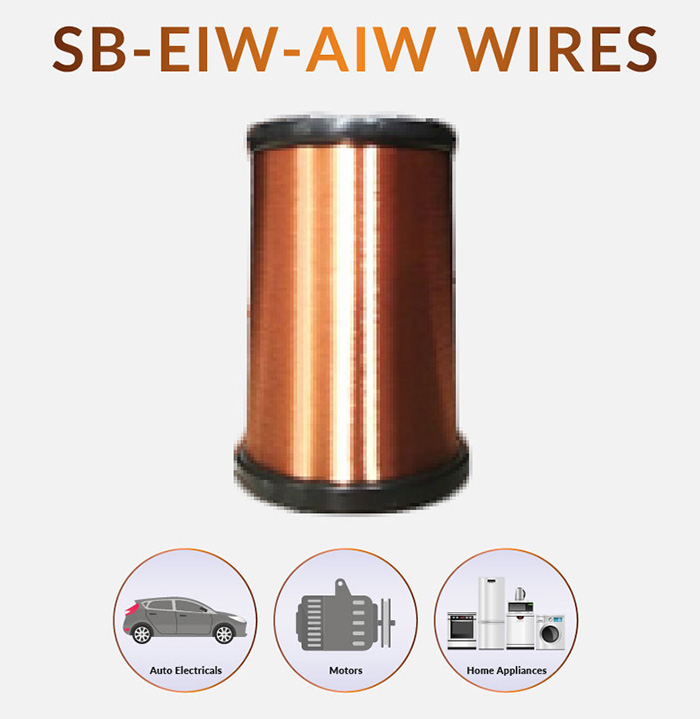
Analysis On the Performance of Self-adhesive Enameled Wire
Machinability
Self-adhesive enameled wire, like ordinary enameled wire, has good processability, measured from windability, formability and insertability. Winding performance refers to the ability of the winding wire to resist mechanical damage and electrical damage during the coil winding process, and the wound coil is the tightest and most compliant. Formability refers to the ability to withstand bending and maintain the shape of the coil. When the formability is good, the shape remains unchanged. After being removed from the winding machine, the coil can maintain various angles. The rectangular coil will not bulge into a barrel shape. The line will not jump out. Embedability refers to the ability to embed in the trunking.
compatibility
Compatibility of self-adhesive enameled wire with chemical composition and temperature index of other materials. Other materials used in the products of magnetic components such as transformers: bakelite or metal skeleton, PTFE film or telephone paper (insulation layer), AF lead-out wire, etc., in terms of chemical composition and temperature index, they are all similar to self-adhesive enameled wire compatible.
Temperature Index and Thermal Performance
Generally, according to the allowable temperature rise of the transformer product, or the highest hot spot index that may appear in the coil, the winding wire with the corresponding temperature index is selected. The temperature index of self-adhesive polyester enameled wire is 130°C, and that of self-adhesive direct-soldering polyurethane enameled wire is 120°C. At present, our factory manufactures transformer products, and the temperature index of the enameled wire used is 130°C, but most of them are small-power transformers, and the highest temperature in the working state is generally 70-80°C.
space factor
The design of electronic instruments tends to be dense and miniaturized, reducing the size of the transformer and improving the space factor of the winding are issues that must be considered in the selection of winding wires. For winding wires with the same wire cross-sectional area, the space factor of the foil strip (planar transformer) is the highest, followed by the flat wire, and the round wire is the smallest. Compared with ordinary round enameled wire, the self-adhesive enameled wire does not reduce the volume of the winding, but in some cases, the self-adhesive enameled wire does not need the coil skeleton (inductance coil), which is conducive to improving the product structure.
electrical properties
Self-adhesive enameled wire has the same conductivity as ordinary enameled wire core. Since self-adhesive enameled wire belongs to composite coated enameled wire, the insulating layer has sufficient and stable withstand voltage capacity (breakdown voltage) and insulation resistance, which is higher than ordinary enameled wire. higher.
Mechanical behavior
The selection of winding wire should have appropriate wear resistance, scratch resistance and bending resistance. When the coil winding is subjected to high stress, it is advisable to use composite layer insulated enameled wire. Self-adhesive polyester enameled wire (QZN) and polyester enameled wire QZ have better abrasion resistance and scratch resistance.
Solderability
Ordinary enameled wire (QZ) does not have direct solderability. When welding, it is necessary to use sandpaper or other tools to remove the paint layer, especially when there are many transformer coil leads (with dozens of solder joints), it is quite time-consuming; and when When the wire diameter of the enameled wire is very thin, the wire core is easy to be damaged when the enameled layer is removed. Self-adhesive polyurethane enamelled wire (QAN) and polyester enameled wire QA have direct solderability, which improves the efficiency of transformer terminal processing.
Soldering test: 3 transformers were wound with self-adhesive polyurethane enameled wire (QAN) of Ф0.12, and all terminals were directly welded, and the connection and insulation were good after welding. Some research institutes or manufacturers have given some parameters after the soldering test: 1) For enameled wires with a wire diameter of 0.10mm or less, after immersing in a solder pot with a temperature of 375°C±5°C for 2 seconds, the tinned surface is smooth and there are no needles. holes and paint residue. 2) After the enameled wire with a wire diameter of 0.10mm or more is immersed in a solder pot with a temperature of 375°C±5°C for a specified time t seconds, the tinned surface will be smooth without pinholes and paint residues. The time t is calculated according to the formula, at least 3 seconds. t=K×d, d is the nominal diameter of the enameled wire (mm), K is a constant, 10 for grade 1, and 15 for grade 2.
thermal bonding
Coils wound with self-adhesive enameled wires are co-baked so that the self-adhesive coatings are melted and bonded to each other for physical and chemical actions, and they are fixed and formed by themselves after cooling. Thermal bonding test in the national standard: put the wound sample coil in an oven at a temperature of 170°C±2°C for treatment, apply a specified load, and it must not be pulled apart. The temperature and time of thermal bonding of actual products need to be determined by further experiments to determine the appropriate parameters.
For the application of self-adhesive enameled wire, there are two other indicators of thermal bonding performance: 1) Resoftening temperature is the temperature at which the treated coil with a certain adhesive force loses its adhesive force. The thermal performance of the bonding layer is of practical significance.
Self-adhesive polyurethane and polyester enameled wires have been widely used in micro motors and audio coils. Self-adhesive polyurethane enameled wires have gradually been used in high-frequency coils. With the popularization of surface mount technology, SMD Copper foil or self-adhesive enameled wire should be considered first in the design of a skeletonless transformer.
The high efficiency of self-adhesive enameled wire application has been fully reflected in the case of transformers and other magnetic component products facing large batches and short cycles.

